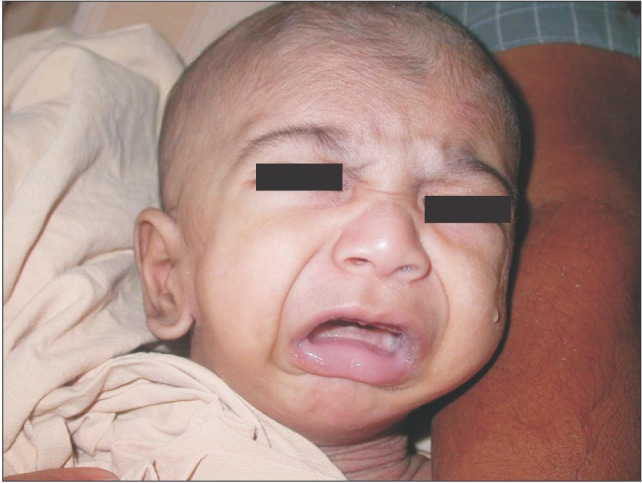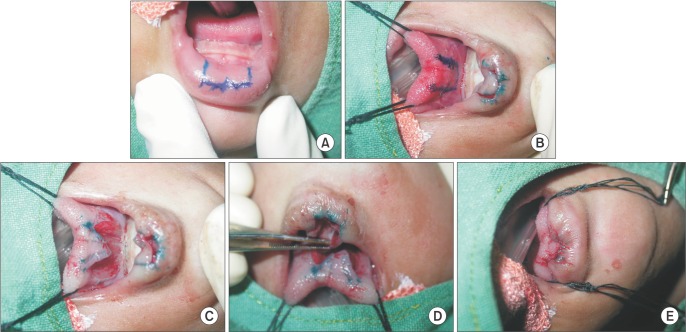J Korean Assoc Oral Maxillofac Surg.
2016 Feb;42(1):47-50. 10.5125/jkaoms.2016.42.1.47.
Tongue-lip adhesion in Pierre Robin sequence
- Affiliations
-
- 1Department of Plastic and Reconstructive Surgery, Baby Memorial Hospital, Calicut, India. anand6527@gmail.com
- 2Department of Maxillofacial Surgery, Baby Memorial Hospital, Calicut, India.
- KMID: 2189414
- DOI: http://doi.org/10.5125/jkaoms.2016.42.1.47
Abstract
- Patients with Pierre Robin sequence exhibit varying degrees of airway obstruction and feeding difficulty. In some patients, airway obstruction may be profound, warranting surgical intervention to maintain a patent airway. The purpose of this article is to highlight the advantages of the tongue-lip adhesion procedure for the management of airway obstruction in such patients compared to the currently available options.
Figure
Reference
-
1. Huang F, Lo LJ, Chen YR, Yang JC, Niu CK, Chung MY. Tonguelip adhesion in the management of Pierre Robin sequence with airway obstruction: technique and outcome. Chang Gung Med J. 2005; 28:90–96. PMID: 15880984.2. Benjamin B, Walker P. Management of airway obstruction in the Pierre Robin sequence. Int J Pediatr Otorhinolaryngol. 1991; 22:29–37. PMID: 1917336.
Article3. Kirschner RE, Low DW, Randall P, Bartlett SP, McDonald-Mc-Ginn DM, Schultz PJ, et al. Surgical airway management in Pierre Robin sequence: is there a role for tongue-lip adhesion. Cleft Palate Craniofac J. 2003; 40:13–18. PMID: 12498601.
Article4. Denny AD, Talisman R, Hanson PR, Recinos RF. Mandibular distraction osteogenesis in very young patients to correct airway obstruction. Plast Reconstr Surg. 2001; 108:302–311. PMID: 11496167.
Article5. Douglas B. The treatment of micrognathia associated with obstruction by a plastic procedure. Plast Reconstr Surg (1946). 1946; 1:300–308. PMID: 20278146.
Article6. Sher AE, Shprintzen RJ, Thorpy MJ. Endoscopic observations of obstructive sleep apnea in children with anomalous upper airways: predictive and therapeutic value. Int J Pediatr Otorhinolaryngol. 1986; 11:135–146. PMID: 3744695.
Article7. Augarten A, Sagy M, Yahav J, Barzilay Z. Management of upper airway obstruction in the Pierre Robin syndrome. Br J Oral Maxillofac Surg. 1990; 28:105–108. PMID: 2110818.
Article8. Routledge RT. The Pierre-Robin syndrome: a surgical emergency in the neonatal period. Br J Plast Surg. 1960; 13:204–218. PMID: 13744041.
Article9. Randall P. The Robin anomalad: micrognathia and glossoptosis with airway obstruction. In : Converse JM, editor. Reconstructive plastic surgery. Philadelphia: WB Saunders;1977. p. 2235–2245.10. Argamaso RV. Glossopexy for upper airway obstruction in Robin sequence. Cleft Palate Craniofac J. 1992; 29:232–238. PMID: 1591256.
Article11. Delorme RP, Larocque Y, Caouette-Laberge L. Innovative surgical approach for the Pierre Robin anomalad: subperiosteal release of the floor of the mouth musculature. Plast Reconstr Surg. 1989; 83:960–964. PMID: 2727168.
- Full Text Links
- Actions
-
Cited
- CITED
-
- Close
- Share
- Similar articles
-
- Tongue-Lip Adhesion Using an Alveolar Protector Appliance for Management of Pierre Robin Sequence
- Application of Temporary Tongue-Lip Traction During the Initial Period of Mandibular Distraction in Pierre Robin Sequence
- Surgical treatment of airway obstruction in infants with Pierre Robin sequence
- Two Cases of Pierre Robin Syndrome Managed with Tongue-Lip Adhesion and Tracheostomy
- Mandibular distraction osteogenesis in an infant with pierre robin sequence: Report of a case




